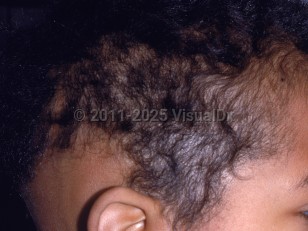Radiation-induced alopecia - Hair and Scalp
Alerts and Notices
Important News & Links
Synopsis

Radiation-induced alopecia (RIA) commonly follows x-ray exposure from therapeutic radiation for head and neck cancers and sometimes follows diagnostic and interventional radiology examinations. Host biologic factors such as age, tissue hypoxemia, genetic factors, and nutrition factors interplay with exposure-related factors such as dose fractionation, dose rate, and the size of the radiation window to determine the severity of the tissue injury.
RIA is typically an intense anagen effluvium due to radiation interrupting rapid mitotic activity during the anagen hair growth stage. Despite advancement in dose fractionation and tissue-sparing delivery of radiotherapy, rapidly proliferating hair follicles are still at elevated risk for damage.
RIA can be categorized as either temporary (tRIA), characterized by hair restoration within 6 months, or persistent (pRIA), indicating hair loss that extends beyond 6 months from the completion of the final treatment. pRIA can have persistent miniaturization of up to 1.5 years, but in some individuals, hair regrowth takes up to 6 years.
Permanent cicatricial alopecia may occur if high-dose radiation has completely obliterated hair follicles.
Alopecia, whether temporary or permanent, may manifest when exposed to radiation doses exceeding approximately 3 Gy and 7 Gy, respectively. There is a dose-dependent phenomenon where a 1-unit increase in radiation is correlated with increased severity of alopecia. Distribution is also correlated with the treatment area.
Proton therapy, compared to traditional photon therapy, is thought to spare healthy tissues located beyond a tumor. While it is rarer to experience RIA with this therapy, it is still possible.
RIA is typically an intense anagen effluvium due to radiation interrupting rapid mitotic activity during the anagen hair growth stage. Despite advancement in dose fractionation and tissue-sparing delivery of radiotherapy, rapidly proliferating hair follicles are still at elevated risk for damage.
RIA can be categorized as either temporary (tRIA), characterized by hair restoration within 6 months, or persistent (pRIA), indicating hair loss that extends beyond 6 months from the completion of the final treatment. pRIA can have persistent miniaturization of up to 1.5 years, but in some individuals, hair regrowth takes up to 6 years.
Permanent cicatricial alopecia may occur if high-dose radiation has completely obliterated hair follicles.
Alopecia, whether temporary or permanent, may manifest when exposed to radiation doses exceeding approximately 3 Gy and 7 Gy, respectively. There is a dose-dependent phenomenon where a 1-unit increase in radiation is correlated with increased severity of alopecia. Distribution is also correlated with the treatment area.
Proton therapy, compared to traditional photon therapy, is thought to spare healthy tissues located beyond a tumor. While it is rarer to experience RIA with this therapy, it is still possible.
Codes
ICD10CM:
L65.8 – Other specified nonscarring hair loss
SNOMEDCT:
22934003 – Radiation alopecia
L65.8 – Other specified nonscarring hair loss
SNOMEDCT:
22934003 – Radiation alopecia
Look For
Subscription Required
Diagnostic Pearls
Subscription Required
Differential Diagnosis & Pitfalls

To perform a comparison, select diagnoses from the classic differential
Subscription Required
Best Tests
Subscription Required
Management Pearls
Subscription Required
Therapy
Subscription Required
References
Subscription Required
Last Reviewed:03/17/2025
Last Updated:03/06/2024
Last Updated:03/06/2024
Radiation-induced alopecia - Hair and Scalp

